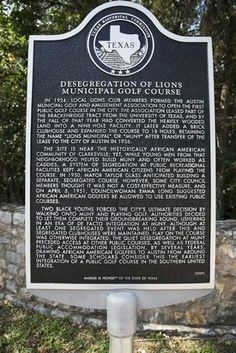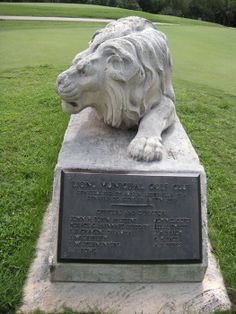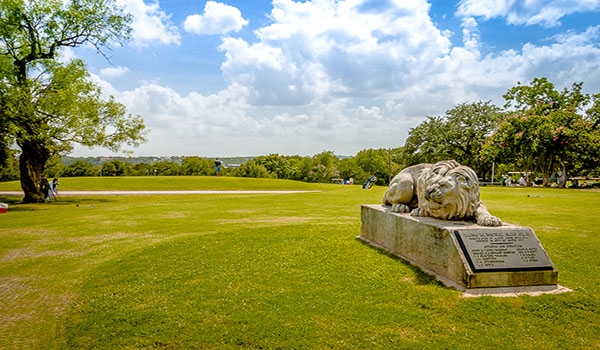Washington – The National Trust for Historic Preservation unveiled its list of America’s 11 Most Endangered Historic Places, an annual list that spotlights important examples of the nation’s architectural and cultural heritage that are at risk of destruction or irreparable damage.
More than 270 sites have been on the list over its 29-year history, and in that time, fewer than five percent of listed sites have been lost. On the list is Austin’s Lions Municipal Golf Course, the first Municipal golf course to desegregate in the South. Located in Austin, Texas, the course was listed on the National Register of Historic Places in 2016.
 The National Trust’s 29th annual list includes historic places in America’s urban areas at a time when cities across the nation are experiencing a resurgence. Millions of Americans—especially younger people—are choosing to relocate to urban areas, with many opting to live in distinctive, character-rich older and historic neighborhoods. Preservation is playing a key role in this trend, and our research suggests that older buildings are one of the most powerful tools we have for the continued revitalization of our nation’s urban centers.
The National Trust’s 29th annual list includes historic places in America’s urban areas at a time when cities across the nation are experiencing a resurgence. Millions of Americans—especially younger people—are choosing to relocate to urban areas, with many opting to live in distinctive, character-rich older and historic neighborhoods. Preservation is playing a key role in this trend, and our research suggests that older buildings are one of the most powerful tools we have for the continued revitalization of our nation’s urban centers.
“For nearly 30 years, our list of America’s 11 Most Endangered Historic Places has called attention to threatened one-of-a-kind treasures throughout the nation and galvanized local communities to help save them,” said Stephanie Meeks, president of the National Trust for Historic Preservation. The list was released last October.
 “This list elevates important threatened historic places in our nation’s cities at a time when more than 80 percent of Americans live in urban areas. We know that preservation is an essential part of the current urban renaissance and that old buildings contribute to the sustainability and walkability of our communities. Historic buildings are also powerful economic engines that spur revitalization, meet a broad range of human needs, and enhance the quality of life for us all. With thoughtful and creative policy approaches and tools, we can tap the full potential of these important places and secure a foundation for a stronger and more vibrant future.”
“This list elevates important threatened historic places in our nation’s cities at a time when more than 80 percent of Americans live in urban areas. We know that preservation is an essential part of the current urban renaissance and that old buildings contribute to the sustainability and walkability of our communities. Historic buildings are also powerful economic engines that spur revitalization, meet a broad range of human needs, and enhance the quality of life for us all. With thoughtful and creative policy approaches and tools, we can tap the full potential of these important places and secure a foundation for a stronger and more vibrant future.”
While bringing attention to urban sites, the 2016 list also includes places that reflect the broader diversity of America’s historic places, from Bears Ears in Southeastern Utah to the James River at Jamestown, Virginia.
Members of the public are invited to learn more about what they can do to support these 11 historic places and hundreds of other endangered sites at www.SavingPlaces.org/11Most
The 2016 list of America’s 11 Most Endangered Historic Places (in alphabetical order):
Austin’s Lions Municipal Golf Course – Austin, Texas. Widely regarded as the first municipal golf course in the South to desegregate, “Muny” is an unheralded civil rights landmark facing development pressure.
Azikiwe-Nkrumah Hall at Lincoln University – Lincoln, Pa. The oldest building on the campus of the first degree-granting institution in the nation for African Americans, this hallowed building currently stands empty and faces an uncertain future.
Bears Ears – Southeastern Utah. The 1.9 million-acre Bears Ears cultural landscape features a world-class collection of archaeological sites, cliff dwellings, petroglyphs, and ancient roads that illuminate 12,000 years of human history yet is now threatened by looting, mismanaged recreational use, and energy development.
Charleston Naval Hospital District – North Charleston, S.C. The historic district played a prominent role during WWII as a primary re-entry point for American servicemen injured in Europe and Africa. Now threatened by a proposed rail line, this important historic resource is at risk of being largely destroyed.
Delta Queen – Houma, La. This steamboat was built in 1926 and today is among the last of her kind. Federal legislation that would enable this prestigious ship to return to overnight passenger cruising remains a key piece to securing the Delta Queen’s sustainability and future.
El Paso’s Chihuahuita and El Segundo Barrio Neighborhoods – El Paso, Texas. These historic neighborhoods form the core of El Paso’s cultural identity, but their homes and small businesses are threatened by demolition.
Historic Downtown Flemington – Flemington, N.J. Historic buildings at the core of the town that hosted the ‘Trial of the Century,’ the Charles Lindbergh baby kidnapping trial, are threatened by a development proposal that would demolish the iconic Union Hotel along with three other adjacent historic buildings.
James River – James City County, Va. Jamestown, America’s first permanent English settlement, was founded along the banks of the James River in 1607. The river and landscape, also named to this list by the Trust in 2013, remain threatened by a proposed transmission line project that would compromise the scenic integrity of this historic area.
Milwaukee’s Mitchell Park Domes – Milwaukee, Wis. A beloved Milwaukee institution for generations, a unique engineering marvel and a highly significant example of midcentury modern architecture, the Milwaukee Domes are facing calls for their demolition.
San Francisco Embarcadero – San Francisco, Calif. The City by the Bays’ iconic waterfront is beloved by residents and visitors alike, but needs long-term planning to address the dual natural threats of sea level rise and seismic vulnerability.
Sunshine Mile – Tucson, Ariz. This two-mile corridor on Tucson’s Broadway Boulevard features one of the most significant concentrations of historic mid-century modern architecture in the Southwest. This unique collection of properties face threats from a transportation project that would require demolition.
America’s 11 Most Endangered Historic Places has identified more than 270 threatened one-of-a-kind historic treasures since 1988. Whether these sites are urban districts or rural landscapes, Native American landmarks or 20th-century sports arenas, entire communities or single buildings, the list spotlights historic places across America that are threatened by neglect, insufficient funds, inappropriate development or insensitive public policy. The designation has been a powerful tool for raising awareness and rallying resources to save endangered sites from every region of the country. At times, that attention has garnered public support to quickly rescue a treasured landmark; while in other instances, it has been the impetus of a long battle to save an important piece of our history.
The National Trust for Historic Preservation, a privately funded nonprofit organization, works to save America’s historic places. www.SavingPlaces.org



